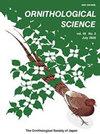温度和雪深解释了黄斑羚的繁殖分布格局
IF 0.3
4区 生物学
Q4 ORNITHOLOGY
引用次数: 0
摘要
摘要许多分布不均的鸟类正面临灭绝的危险。识别和阐明解释这些分布模式的环境因素对于制定有效的保护策略至关重要。黄鹀是一种在日本繁殖分布不均的濒危候鸟。本文利用日本全国种鸟调查的大量数据,明确了黄鹀繁殖范围的空间分布和海拔高度范围,并检测了影响其分布格局的环境因素(如气候和地形)。利用最大熵模型(MaxEnt)分析了1997-2002年黄斑猎在繁殖期(温度、雪深、海拔、三级层、滑坡面积和森林边缘密度6个环境因子的存在情况。我们发现,在本州北部(日本主岛)的调查网格中,黄鹀的比例高于该国其他地方,它们主要发生在海拔700米以下的地区。此外,被占领网格的高程随纬度而降低。温度和雪深对黄斑天牛繁殖分布的影响最大(分别为0.380和0.350)。研究结果表明,较低的温度和较深的积雪是黄斑鹀繁殖分布的关键决定因素。在较冷的地区,可能有丰富的猎物和较少的鸟类竞争对手,如留鸟物种,更频繁的雪崩和融雪的水可能建立了黄鹀喜欢的沼泽和灌木丛栖息地。这些发现对于制定有效的濒危黄猎保护策略至关重要。由于过去的大规模诱捕也可能影响了黄鹀的异质性分布,这是未来从不同角度研究黄鹀的重要途径。本文章由计算机程序翻译,如有差异,请以英文原文为准。
Temperature and Snow Depth Explain the Breeding Distribution Pattern of Yellow Bunting Emberiza sulphurata
Abstract Many bird species with heterogeneous distribution are at risk of extinction. It is essential to identify and elucidate environmental factors explaining such distribution patterns to develop effective conservation strategies for those species. Yellow Bunting Emberiza sulphurata is an endangered migrant bird species exhibiting heterogeneous breeding distribution in Japan. Here we clarify the spatial distribution and the altitudinal range of the Yellow Bunting breeding range, and detect environmental factors (e.g., climate and topography) influencing their distribution pattern using an extensive dataset from the national breeding birds survey of Japan. The presence of Yellow Bunting during the breeding season (1997–2002) and six environmental factors (temperature, snow depth, elevation, tertiary layer, landslide area and forest edge density) were analyzed using maximum entropy models (MaxEnt). We found that Yellow Buntings were present in a higher proportion of survey grids in northern Honshu (the main island of Japan) than elsewhere in the country, and they mainly occurred in areas below 700 m above sea level. Moreover, the elevation of the occupied grids decreased with latitude. Temperature and snow depth were of greater importance (0.380 and 0.350, respectively) than other factors in explaining the breeding distribution of the Yellow Bunting. Our study highlighted the location of the core areas of the Yellow Bunting's breeding distribution, and demonstrated that lower temperature and deeper snow cover are the critical determinants of those areas. There may be abundant prey and fewer avian competitors, such as resident bird species, in colder regions, and more frequent snow avalanches and water from melting snow may establish the marshy and bushy habitat preferred by Yellow Buntings. These findings are essential for developing effective conservation strategies for the endangered Yellow Bunting. As past mass-trapping may have also influenced the heterogeneous distribution of the Yellow Bunting, this is an important avenue for future research from a different perspective.
求助全文
通过发布文献求助,成功后即可免费获取论文全文。
去求助
来源期刊

Ornithological Science
ORNITHOLOGY-
CiteScore
1.20
自引率
0.00%
发文量
26
审稿时长
>12 weeks
期刊介绍:
Ornithological Science publishes reviews, original articles, short communications and comments covering all aspects of ornithology. Manuscripts are judged on the basis of their contribution of original data and ideas or interpretation. All articles are peer-reviewed by at least two researchers expert in the field of the submitted paper. Manuscript are edited where necessary for clarify and economy. Ornithological Science aims to publish as rapidly as is consistent with the requirements of peer-review and normal publishing constraints.
 求助内容:
求助内容: 应助结果提醒方式:
应助结果提醒方式:


